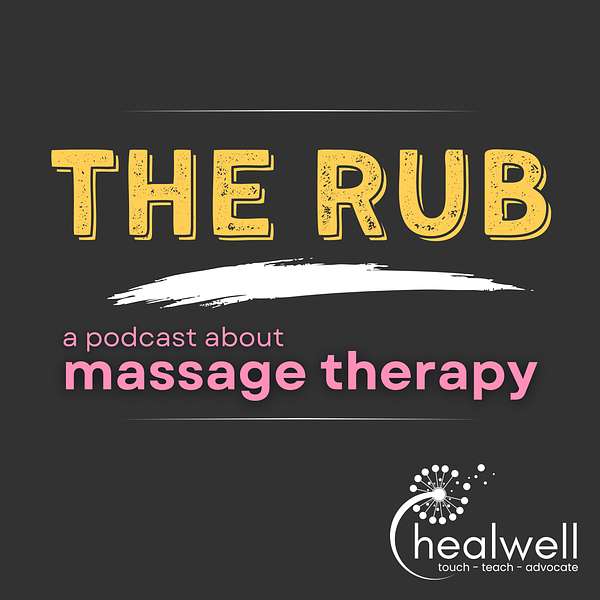
The Rub: a podcast about massage therapy
Join Healwell in examining and bringing context to the world of massage therapy beyond the table. We have ideas. We have opinions. We want change, and that will only come with an understanding of who and what massage therapy truly is. A variety of topics are up for grabs: history, philosophy, development, and all the other shiny things that fascinate us.
Healwell is a non-profit based out of the Washington DC area. Check us out at www.healwell.org
The Rub: a podcast about massage therapy
A Profession-Wide Mental Health Crisis
The episode discusses the hidden mental health crisis within the massage therapy profession, spotlighting alarming suicide rates and the pressing need for open dialogue and community support. By exploring the complexity of suicidal ideation and the current model we use to understand suicide, we aim to equip listeners with tools to recognize and address these critical issues.
Suicide hotline: call or text 988
International Suicide Hotlines
Register for the Community Processing Event on February 25th
CDC Article: Suicide Rates by Industry and Occupation
Healwell Class: Empowering Individuals to Navigate Crisis
Integrated Motivational Volitional Model of Suicidal Behavior
Entrapment Scale
Boring Books for Bedtime Podcast
PBS Documentary: Facing Suicide
When It Is Darkest: Why People Die by Suicide and What We Can Do to Prevent It
Send us an email: podcast@healwell.org
Leave us a voice message: 703-468-1799
Check out our interview-style podcast: Interdisciplinary
You can support Healwell and the cool things we make by donating here!
Other ways join in:
- Leave us a review on Apple Podcasts
- Check Healwell’s live and online classes
- Continue the conversation with a free 3-day trial of the Healwell Community
- Find a copy of Rebecca Sturgeon's book: "Oncology Massage: An Integrative Approach to Cancer Care"
Thank you to ABMP for sponsoring us!
Healwell is a 501(c)(3) non-profit based out of the Washington DC area. Check us out at www.healwell.org
This episode contains discussions about suicide. If you or someone you know is experiencing suicidal thoughts or a crisis, call or text 988 on your phone to reach the Suicide Hotline in the United States. For hotlines outside the United States, click the Lifeline link in the show notes. Most people listen to podcasts while they do other things, like driving chores, or if you're a massage therapist, turning over your room between clients. This episode contains some heavy and potentially upsetting information. If suicide is a topic you think you might find triggering and you aren't in a place where you can put down what you're doing and perform some care of self, please wait to listen to this episode and remember we can do hard things together. Can do hard things together. Welcome to the Rub, a podcast about massage therapy. I'm your host, kori Rivera, licensed massage therapist and information magpie, and today we're talking about suicide statistics for massage therapists. I wish this episode wasn't coming out at this particular moment in time, but here it is and here we are. I don't wish to add to your burdens, but the problem we're talking about today exists whether we talk about it or not. Our hope is that, by affirming that you are not alone in your thoughts and experiences, we can build a community that can support its members and work to solve its problems.
Speaker 1:In December of 2023, the Centers for Disease Control published a report of industry and occupational suicide rates for the year 2021. The CDC has published reports like this before, but this was the first time occupation was required on all death certificates. Previous reports included 12 and then 39 states, which makes it hard to draw national-level conclusions. The industry and occupation rates only seem to be released every four or so years, so there is no more information yet. The CDC report includes 254 industries, which are very broad categories, and 492 occupations, which are specific jobs within an industry. The report separates the information into male and female categories. The occupation of massage therapy ranked fourth highest in the country for females, the industry of beauty salons ranked fourth and the industry of nail salons and other personal care ranked fifth highest for females. Both of those industries employ massage therapists. So, out of almost 500 occupations, massage therapy had the fourth highest suicide rate for females in the year 2021. And, out of 250 industries, massage therapists potentially work in the industries that had the fourth and fifth highest suicide rates for females. The next important question is how much higher is this rate than average For massage therapists as a group including men and women, the rate was 25.8 per 100,000 in the year 2021. That is nearly double the national rate and it is four times the national rate for females. That's important because massage therapists are at least 85% female identified. Healwell has slowly told people in the massage therapy profession about this statistic. One of our staff members discovered it last July while looking for statistics about veterinarians.
Speaker 1:People have had many reactions. Some people get very quiet and still Some people try to verbally process immediately. Some people get very quiet and still Some people try to verbally process immediately. Some people outright deny it at first. Any reaction you're having right now is valid. Remember, we can do hard things together. On February 25th at 7 pm Eastern Standard Time, healwell will be holding an online processing and community support session with the help of licensed social worker Jen Brandl. Admission is free, but you will need to register at the link in the show notes We've also included a link to a class Jen Brandl made for HealWell that you might find helpful. If you or someone you know is experiencing suicidal thoughts or a crisis, call or text 988 on your phone to reach the Suicide Hotline in the United States. For hotlines outside the United States. Click the Lifeline link in the show notes.
Speaker 1:In this episode we're going to talk about what suicide is, some ways to think and talk about it and what to do if you or someone you know is in a crisis. There is never a single cause of suicide. The question of why that follows a death by suicide can never be fully answered because it is so complicated. But despite the things we can't answer, there are things we do know. Over the last decade, researchers have developed an understanding of how suicidal behavior happens and what contributes to it. We have strategies for intervention and supporting people who are experiencing suicidal ideation. When talking about suicide, we used to use the phrases committed suicide and successful suicide. Committed comes from a time when suicide was considered a crime and in some places it still is. Successful is no longer used because a success is a good thing and as a society we can understand suicide and have empathy for people who die by it. But the word success is ill-fitting at best. The phrases died by suicide or ended their life are used more often now because both acknowledge the agency of the person who died without adding judgment.
Speaker 1:One of the biggest struggles of writing this episode has been the urge to focus on telling you how to help other people, how you, as a massage therapist, can support people struggling with suicide. Most of our education as massage therapists is focusing on helping others. Our self-care classes are often about ergonomics or meditation, partly for our own health, but mostly so that we can avoid physical or mental injury and keep working, keep helping. But this episode is about you, not your clients. It is astoundingly easy to slip into language that other people struggle with suicide, how to help them. It's human nature to find ways to rationalize why something bad can't happen to us, why we're protected when someone else might not be.
Speaker 1:A common myth is that people who talk about suicide are not at risk. I'm here to tell you from personal experience that talking about it doesn't create a risk-free zone, but not talking about it doesn't make us safer either. Another common way to justify feeling safe from suicide risk is whether or not we suffer from mental illness. 70% of people who attempt suicide have a documented mental illness, but the vast majority of people who have a mental illness will never make an attempt and, conversely, 30% of people who attempt suicide have no history of mental illness. People who attempt or die by suicide are people exactly like you and exactly like me.
Speaker 1:Suicide is not a weakness or a moral failing. People who die by suicide are experiencing unbearable, searing emotional and psychological pain. Suicide attempts are less about wanting to be dead and more about not being able to imagine a future without this pain. This inability to imagine a different future is known as cognitive constriction or tunnel vision. It can be difficult to understand why another person would choose suicide, but, as one of the books I read stated, what you see is not what they see. As a person who has persistent suicidal ideation which is what we call the experience of having thoughts about suicide I can tell you that what I see is different thoughts about suicide. I can tell you that what I see is different. After I learned about cognitive constriction while I was researching this episode, I began to notice when my vision narrows and when all of my potential futures condense into a single, unbearable pathway. I can also see when the constriction eases and the present once again feels temporary, and the future feels both blurry and changeable.
Speaker 1:About a decade ago, a model was created to explain how suicidal ideation develops and how it can turn into action. The model is called the Integrated Motivational Volitional Model of Suicide Behavior. I know that's a mouthful. I'm the one who just said it and it took me three tries. The model is important because it allows us to discuss suicide as a series of happenings, instead of some dark, mysterious fog of the unknown. It allows us to understand where people are in their experience of suicide and how we might be able to help. I want to take this moment to tell you that I use academic names for things on this podcast because it is the fastest way for you to find more information on a topic. The phrase tunnel vision is immediately understandable, but a Google search of those words will come up with a wide variety of topics, including a loss of peripheral vision and a clothing line. Doing a search for cognitive constriction will take you to suicide prevention resources. Okay, the integrated motivational volitional model.
Speaker 1:The model has three phases, which can be described as vulnerability, motivation and action. Vulnerability is the first phase. It covers the background reasons you might have an increased risk of suicidal behavior. We're going to talk about this in the next episode because it is a very, very large topic, and today I think it's more important to talk about the second and third phases where intervention needs to happen. Factors of vulnerability include things like your life history and the environment you live in. The second phase, motivation, covers thoughts about suicide. The third and final phase is taking action. So vulnerability, motivation, action Each phase has different factors that contribute to it. This means that what contributes to thoughts of suicide is different than what contributes to the act. It is also important to know that not everyone will move all the way through the model. Having suicidal ideation does not mean you will make an attempt. The point of the model is to be able to identify where people are, what might increase the possibility of them taking action and, most importantly, what we might be able to do to interrupt or stop their progress towards that action. So the first phase is vulnerability or risk, and we'll expand on that in the next episode.
Speaker 1:The second phase of the model, motivation, is primarily driven by feelings of inescapable defeat. These feelings of defeat lead to a feeling of entrapment, feeling like there's no way out of the situation you're in. Entrapment can then lead to thoughts of suicide. Remember, suicide isn't about wanting to die, it is about escaping unbearable pain. So, to repeat in phase two, feelings of defeat lead to feelings of entrapment, which lead to thoughts of suicide. There are several factors that can increase or decrease feelings of defeat. Factors that affect feelings of defeat are psychological. They include things like problem solving, coping, memory bias and rumination. When those things are going swimmingly, they decrease feelings of defeat. When they're going badly, they increase feelings of defeat. These things are also intertwined. If you struggle with memory bias or tending to remember bad things and forgetting good ones, that can make problem solving difficult. We rely on past experiences to help us solve current problems, but if you can't remember the times you succeeded, it's a lot harder to repeat that success. You feel more defeated because your mind can't find the solution. So defeat leads to entrapment and entrapment leads to thoughts of suicide.
Speaker 1:There's a simple questionnaire called the Entrapment Scale that helps assess feelings of entrapment. There's a short version of it that contains four statements. Those statements are one I often have the feeling that I would just like to run away. Two I feel powerless to change things. Three, I feel trapped inside myself. And four I feel I'm in a deep hole that I can't get out of. The first two statements refer to a feeling of external entrapment or feeling trapped by your circumstances. The last two statements are internal entrapment. Those last two feeling trapped inside myself and being in a deep hole are more dangerous because they are more likely to lead to suicidal ideation.
Speaker 1:The factors that affect the feeling of entrapment are motivational instead of psychological. Things that increase the feeling of entrapment are motivational instead of psychological. Things that increase the feeling of entrapment include things like feeling like you're a burden, feeling like you don't belong, having few positive thoughts about the future, not having social support and lacking resilience. Again, feelings of entrapment are not always going to turn into ideation. The third phase of the model is about what increases the likelihood of suicidal ideation turning into a suicide attempt.
Speaker 1:These factors involve a person's will and they run the gamut of being psychological, social, physical and environmentally based. They include access to means, having a plan, exposure to suicide, impulsivity, fearlessness about death, mental imagery, sensitivity to physical pain and past behavior. Let's break those down. Fearlessness about death, mental imagery and sensitivity to physical pain are all straightforward. If you have no fear of death, taking the step to act on ideation is a much smaller step. If you experience mental imagery of yourself after death or of you taking a suicidal action, it can act as a kind of mental rehearsal, which makes it more likely that you'll complete the action. Conversely, if you have a high sensitivity to physical pain, you are less likely to purposefully harm yourself. Let's talk about access to means, having a plan and impulsivity together.
Speaker 1:The act of suicide happens in a window of time. This window is when the feelings become their most intense and people take action. The window lasts between one and ten minutes. It may happen again in a minute or an hour or a day, but the overwhelming urge is short-lived, although it feels like an eternity. It is also possible that that urge might exist in a sustained, low-grade way. If a person already has a plan and has the tools to complete that plan, it is much easier to take action during this window. If they have impulsive tendencies, it also increases the chance of acting in the window. This is why the existence of firearms is an incredibly important factor in suicide.
Speaker 1:Attempts involving anything other than a firearm are 5 to 10% likely to be completed. Attempts with firearms are 90 to 95% likely to be completed. If you are experiencing ideation and have a firearm in your home, please follow gun safety procedures or ask someone you trust to keep it for a while. This is also something you can do with other means. If you have a plan, remove your access to the things you need to complete it. If you or someone you are speaking with has a specific plan and access to the means and isn't sure they can keep themselves safe, it is time to call a professional. That might be a general practitioner, a mental health expert or emergency services.
Speaker 1:Okay, the last two factors that increase the likelihood of moving from ideation to action are past behavior and exposure. The best predictor of a suicide attempt is previous self-harm, whether it was meant to be lethal or not. However, like many things in this episode, this does not mean that everyone who engages in self-harm will attempt suicide, just like a large number of people who attempt or complete suicide have a diagnosed mental illness. But most people with mental illness will not make an attempt. Exposure is the last factor and it is the one that has worried me the most while researching and writing this episode. There is evidence that having a family member or someone close to you exhibit suicidal behavior can increase your risk. However, the evidence does not show a direct line. Remember, suicide always, always, always has more than one reason or risk factor and like having passed self-harmful behavior or a mental illness, the vast majority of people who are exposed to suicide will never attempt it. While the evidence shows a link, we don't understand how that link works. It could be that seeing someone else's action eases the mental friction of the idea, allowing it to become less taboo and more of an option. It may increase our likelihood of modeling that behavior because it was done by someone we perceive to be like us or someone we can relate to.
Speaker 1:When Robin Williams died, the media ignored the rules and guidelines about reporting on suicide. They included the words suicide in headlines, discussed details, romanticized the event and failed to provide resources for their readers. According to a report by Columbia University, there was an estimated 10% increase in suicides after that reporting. But everything that I read agreed there was no contest between not talking and talking responsibly. Talking responsibly is vital to suicide prevention. Talking responsibly is vital to suicide prevention.
Speaker 1:In the last part of this episode, we're going to discuss actions you can take to keep yourself and others safe. If you or someone you know is experiencing suicidal thoughts or a crisis, call or text 988 on your phone to reach the Suicide Hotline in the United States. For hotlines outside the United States, click the Lifeline link in the show notes. Let's talk about you first. Things are hard right now. If you're experiencing defeat, entrapment, suicidal ideation or attempts, there are things you can do. Call the helpline. It only exists for one reason and it is to help you. If you feel like you or someone else is in immediate danger, call emergency services or contact a general practitioner or mental health professional, as mentioned earlier. Remove anything that you would consider using in an attempt. Ask someone you trust to hold on to it for you. If you are experiencing that window where thoughts feel like they could become actions. Don't be alone. If you don't have a person, you can go to, go to the library or other place with people. You don't need to interact. Just don't be alone. Even if you're not in that emergency place, seek out help. General practitioners or local mental health clinics are good places to ask, because both will know what resources are available in your area. You can tell both places that you are having thoughts of suicide. You don't need to sugarcoat anything. They are professionals and they can help you much easier if they understand the gravity of your situation. We don't have good tools to predict suicide attempts. Any screening tools we've tried to develop are about 50% reliable. So just as your general practitioner shouldn't rely on those tools to find the truth, neither should you rely on those tools to tell your doctor the truth.
Speaker 1:For longer-term treatment, talk therapy can be a very powerful tool. Some kinds of talk therapy are more general, like dialectical behavioral therapy or DBT, which focuses on balancing the need for change with acceptance, or cognitive behavioral therapy, cbt, which focuses on challenging dysfunctional thoughts and behaviors and learning new skills to navigate problems. Other types of therapy are specific to suicide prevention, such as CAMS, collaborative Assessment and Management of Suicidality. The goal of CAMS is to stabilize people and engage them in the management of their own safety. Talk therapy might be very helpful for you, but sometimes finding a therapist to work with can be a challenge, either because of limited access or because of personality mismatches. All massage therapists are familiar with how important the therapeutic relationship between therapist and client is and how much can be accomplished if that relationship is a good one.
Speaker 1:Your prevention plan might include something called a safety plan. A safety plan is a document that you fill out with a mental health professional. It spells out steps you might take in order to stop you from acting on suicidal feelings. It asks you to write down warning signs, coping and distraction strategies, people you can ask for help, including professionals, and how to make your environment safe. It is important that you fill it out with someone because there might be unexpected challenges to your solutions. For example, if going for a run makes you feel better but it isn't safe to run at night. The person assisting you with the plan will help you think of other plans for when it's dark.
Speaker 1:And, lastly, get some sleep. Really, it sounds simple, but sleep is a key factor in suicide and self-harm prevention. Not sleeping can increase impulsivity and mental disorder and decrease emotional regulation and decision-making power. I start feeling bad in late evening. I get anxious, I worry about things I did or said that day, I start panicking about the state of the world, and now I interpret this as the start your bedtime routine signal. My brain tends to be loud, so I help it out with a pair of headphones wrapped in a headband and excellent podcasts like Boring Books for Bedtime. I highly recommend the Wildflowers Worth Knowing episodes.
Speaker 1:Finally, what can you do to help other people? The most important thing is don't leave someone in a crisis alone and call the helpline. The next thing is how can you recognize when someone is thinking about suicide? There are a few red flags. Have you noticed a change in their behavior, like eating, sleeping, drug taking or risk taking? Are they acting out of character or unpredictably? Do they talk about being trapped or having no future? Do they talk about being a burden to other people? Are they sorting out their life affairs or giving away important possessions? Are they having a hard time dealing with stressful life events like loss or rejection? And, counterintuitively, has their mood suddenly improved? If you know someone who is struggling with thoughts of suicide and their mood improves, check in on them.
Speaker 1:Unfortunately, an improvement in mood doesn't always indicate someone is out of the woods. They may check in on them. Unfortunately, an improvement in mood doesn't always indicate someone is out of the woods. They may actually be more at risk. Their mood lift might be because they have made a decision to take action and are feeling relieved or they may now have enough energy to take an action. You are not, and are not expected to be, a mind reader. Some people are very good at hiding their distress. Sometimes there are no indications that someone was even considering suicide or self-harm. You can only know what people choose to share with you.
Speaker 1:Recently, while I was at the grocery store, I received a text from a friend that said I feel powerless Because I've been writing about this topic for several months. I realized this statement indicated both defeat and entrapment. I immediately moved my cart out of the flow of shoppers and called my friend three times in a row until they picked up. Then I simply said talk to me For the next 35 minutes. I stood in the middle of the baked goods and talked to my friend. We spoke about being overwhelmed by the news, feeling helpless and frantic at the same time, and worrying about friends and family. Overwhelmed by the news, feeling helpless and frantic at the same time, and worrying about friends and family. I told her what I was doing to cope limiting my news intake, calling my representatives and searching for an organization local to me where I can be helpful. I also watch a lot of Star Wars and I'm planning a toast party which is a potluck centered around fancy toast. We talked until my friend felt better. If they hadn't seemed better by the end of the conversation, I probably would have asked them to have their kind and loving spouse join the call so the three of us could talk about what might need to happen next.
Speaker 1:My friend is not having suicidal ideation, but there is no reason to wait until someone has reached that point to start interventions. You can directly ask someone are you thinking about killing yourself? I know it seems like it could cause a problem, but there is no evidence at all that asking that question will put the idea into someone's head. In fact, asking the question can protect the person, because being able to tell someone is a relief. But keep in mind, once you asked, it is now your job to listen and you will need to listen very, very carefully. As massage therapists, we have an instinct to help, but trying to solve someone's problem before you understand what they're experiencing isn't going to be helpful.
Speaker 1:Don't brightside, don't try to talk them out of feeling bad or dismiss what they say. Phrases like everything happens for a reason or it could have been worse are harmful. Also, if they don't want to talk to you. Don't be insulted. Tell them you're concerned about them and ask if there's someone else they'd feel more comfortable talking to. If a person says they don't want to talk and you continue to worry about them, send them a postcard.
Speaker 1:Seriously, in a randomized controlled trial, the University of California sent a two-sentence letter four times a year to people who had been seen for severe depression or suicidal thoughts. Compared to the control group, deaths by suicide dropped significantly, especially in the first two years. The letter said things like it has been some time since you were here at the hospital and we hope things are going well for you. If you wish to drop us a note, we would be glad to hear from you. Tell the person you're worried about that you're glad they came into your office, or glad that they're your friend and that you're looking forward to seeing them again soon. Sometimes a small gesture is the thing that stops someone from taking an action. Being kind to the people around you, even and maybe especially, in simple ways, is a form of suicide prevention. In simple ways is a form of suicide prevention.
Speaker 1:Being a massage therapist is a fulfilling, important, hard job. We work our bodies, minds and souls in the service of others. We hold people in a caring way for a long time. Every time we go to work. We care about other people all day, and then we go home and care about our plants and our pets and our kids and our parents and our partners. We care, but opportunities for us to connect in community with each other are rare. It can feel lonely out there, and if you're lonely and if you're feeling trapped and if you're feeling like you would rather not be here anymore, you're not doing it wrong and you are not alone. You can find us at the community processing session on February 25th. You can join us in the HealWell online community at communityhealwellorg. You can find other massage therapists near you and do something simple like having tea. You do not have to do this alone. Please do not try to do this alone. You are loved, you are important. You are not alone. Thank you for listening.














